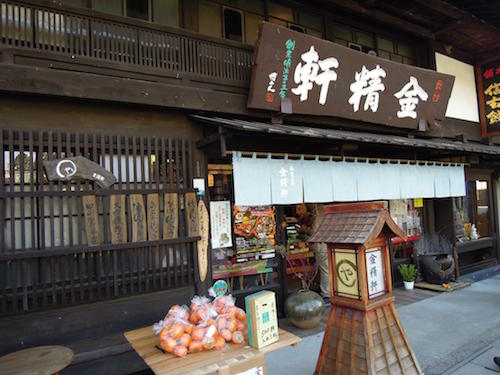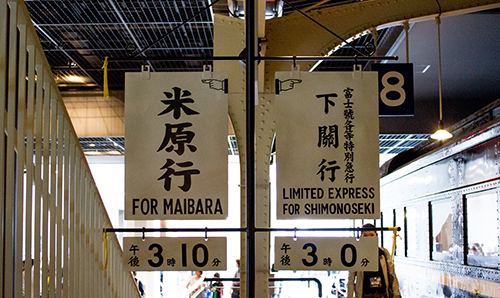119. The "Rice" Radical: 米
With six symmetrical strokes, the "rice" radical 米 looks simple, and that's no illusion. This radical really is that straightforward. Here's what I mean:
• The radical of the following autonomous kanji is called こめ:
米 (201: rice; United States; America (the continent); meter; "rice" radical)
The radical name こめ matches the kun-yomi of this kanji.
• In English, the name of this radical is "rice," again matching what we've seen of 米 as a stand-alone character.
• Aside from the 米 kanji, this radical always appears on the left side of Joyo characters, as in this example:
粘 (1679: sticky; tenacious)
In such cases, the Japanese radical name changes to こめへん, where -へん means "left side of a character." Note that the 米 becomes skinnier when it's shunted to the left.
• In most of the 10 Joyo kanji featuring this radical, the 米 actually means "rice." We'll explore several of those etymologies soon.
Photo Credit: Eve Kushner
The 米 shown here has a connection to food, but not quite as one would expect. The 米吉 is part of the name of a sushi place in Nikko called 米吉晃寿司 (こめきちこうずし). The 晃 is non-Joyo, and a non-Joyo version of 吉 appears here, wherein the top part is 土 rather than 士. The 松原町 (まつばらちょう) on the rock is the name of a section of the city.
A Similar Radical
Henshall (who has supplied all the etymologies in this Radical Note) notes that at some point, people (the ancient Chinese, I suppose) mixed up these two shapes:
radical 119: 米, which represents a "grain-laden ear of rice"
radical 115: 禾, the "grain" radical, which is a pictograph of a "rice plant"
I really can't understand what he's saying in his etymology of 米 (201) about the consequences of this mix-up, but we now have a cautionary tale and should avoid confusing these radicals ourselves!
Rice in Strange Places
There's rice in the restroom! Rice in cosmetics! Rice in the hair salon! It's all thanks to this kanji and its etymology:
粧 (1406: makeup; to adorn oneself)
The 米 here symbolizes "white" and by association represents "face powder." The right side of this character acts phonetically to express "adorn," so all together we have "to adorn oneself with face powder."
The word 化粧 (けしょう) means "makeup," or literally "makeup to change (one's appearance)," and serves as the root of 化粧室 (けしょうしつ: restroom). Euphemistically, that's the "room for powdering one's nose" or the like. Thanks to both of these words, signs with 粧 abound in airports.
Photo Credit: Eve Kushner
With 化粧品 (けしょうひん) , we have "cosmetics." The word 香水 (こうすい) means "perfume."
Photo Credit: Eve Kushner
Photo Credit: Eve Kushner
The largest term in the red sign does not have 化粧 as a root. Instead, 美粧館 (びしょうかん: hair salon) builds on 美粧 (びしょう: makeup). So we're back to rice in makeup!
Rice in Sugar
There's also rice in sugar! I had heard it was the opposite! Here's the story:
糖 (947: sugar)
This character combines 米 (rice) with 唐 (Tang China). The 唐 acts phonetically here to express "dry, heat" and probably also "to pound." Thus, 糖 once symbolized "heated (and pounded?) rice," referring to a type of sweet confection. Later, 糖 evolved to represent "sugar."
Photo Credit: Corey Linstrom
I thought 黒糖 (こくとう or くろとう: black + sugar) would mean "black sugar," but in fact it means "brown cane sugar"! This is a specialty of Okinawa Prefecture.
When 米 Actually Represents Rice
Here are some great examples of Joyo kanji in which our radical etymologically means "rice":
粉 (577: powder; flour)
In this context, the 分 on the right means "to divide or cut into minute pieces." Originally, 粉 meant "to reduce rice to powder." Later the meaning broadened to "powder."
粒 (1900: grain, granule; drop)
The 立 on the right acts phonetically to express "grain," leading 粒 to mean "grain of rice" in the past and later "grain" or "particle" in general.
In the next etymology, our radical only kind of means "rice":
糧 (1912: supply of food)
As "rice," this 米 symbolizes "food" in general. The 量 usually means "quantity" but acts phonetically here to express "road," also conveying "sack full of something." That "something" was "provisions for a journey." Eventually, 糧 came to mean "provisions" in general.
Photo Credit: Eve Kushner
The word 粉末 (ふんまつ) means "fine powder," so the sign reads as follows:
オリーブ葉の粉末が入った
Finely ground olive leaves included
葉 (は: leaf); 入る (はいる: to include)
オリーブソフトクリーム
Soft-serve olive ice cream
That rates a huge BLECH! There is no way that could be good, especially with the olive leaves in there! What were they thinking?!
Purity and Refinement
These three kanji involve purity and refinement or, conversely, coarseness:
精 (725: refining; semen; essence; detailed; energy, spirit)
The apparent blue-greenness (青) on the right lends this kanji connotations of "fresh" and "pure," yielding "pure rice" overall. By extension, the character came to mean "to refine," "detail," "spirit," and "vitality."
粋 (1455: cool, chic; refined; essence; pure)
The right side acts phonetically to express “pound, smash,” according to Henshall's newer edition. Together the two halves mean “rice well pounded and impurity-free,” which is to say “pure.” The meanings “smart” and “stylish” exist only in Japanese.
粗 (1508: coarse)
The right-side phonetic conveys "to neglect" and probably "to accumulate." Originally, then, this character referred to "rice left neglected" (in a storehouse) and later broadened to mean "poor quality, coarse, rough."

Photo Credit: Yoshikazu Kunugi
You need to read the large kanji from right to left:
金精軒 (きんせいけん)
The name of this confectionery in Yamanashi Prefecture (two prefectures north of Tokyo) contains blue-green rice! But thanks to Henshall's explanation, we know we don't have moldy rice on hand! We can't be sure what the 精 in this name means, but the compound 金精 (in which 金 is "gold") can mean "pure gold" or "something beautiful and magnificent." Meanwhile, 軒 is a common way of ending a shop name.

